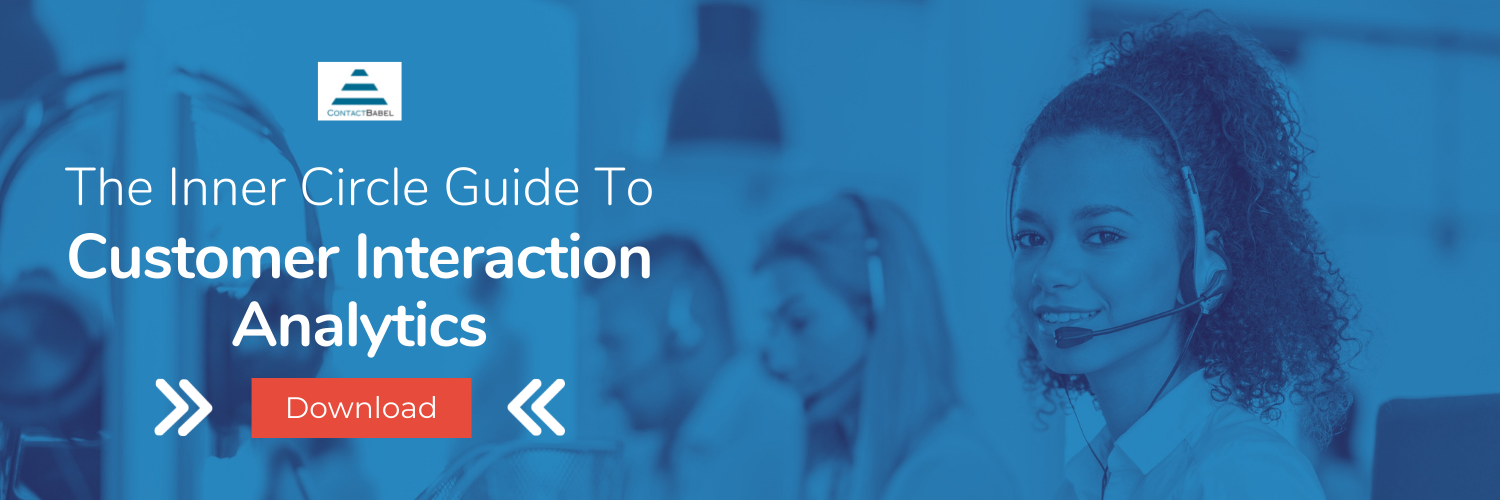5 Critical Pieces of Data Hiding in Your Call Recordings
Every hour of every day, companies launch campaigns to gain awareness of customer feeling about their products and services. They’ll use surveys, cold calls, web bots, questionnaires, feedback prompts, and the list goes on. While all of these methods have merit, they're also flawed because they extract information from our customers at the wrong time.
Truly understanding how your client base feels about you requires examining what they say when they want to talk to you.
If you ask someone how they’re doing and they say “I'm fine, but yesterday was terrible”, you only receive a fraction of their sentiment, because the moment’s over. On the other hand, if that same person tells you how they're feeling on the actual day, it’s a moment of truth, because you’ll experience their words, tone of voice, facial expressions, hand gestures, and so on. Most of all, their feelings are fresh.
For businesses that record phone interactions, these moments of truth occur hundreds of times a day in their own customer service operations. Here are five things to keep an eye out for in your review of customer recordings.
Your call recordings are filled with customer sentiment
Think about inbound calls. An inbound call is when the customer has initiated the call, navigated your IVR menu, and then waited on hold to speak to your call staff. It may not seem like an exceptional effort, but with modern communication offering people so many contact options when a customer makes a voice call you can be sure that they have something important to say to you.
Could be that they want to buy a product, could be they want to cancel the service, could be that they need support. The point is, every inbound call represents a customer's feelings at the moment.
This is where voice analytics play a huge role. Having a voice analytics engine that lets you customize which keywords to track and organize is a benefit no company can expand without. For example, below we can see keywords organized into sentimental columns (satisfied, dissatisfied) and a topical column (support).
.png?width=960&height=540&name=Customer%20Sentiment%20Chart%20(4).png)
Voice analytics tackle the inefficiency of manual call sampling. Companies to devise their voice analytics approach to track words specifically relevant to their business. This could be the names of all your competitors, the titles of your products, common phrases for support issues, and new business opportunities.
Uncover metrics through voice analytics Companies are constantly calculating various totals to build metrics. Perhaps a supervisor needs to know the number of item returns, service cancellations, products damaged in shipping, or how often a specific complaint is occurring. These numbers are extractable from your call recordings. Employing a voice analytics program will powerfully impact your operational awareness, and can even alert you to business growth opportunities. More on that later.
Metadata reveals customer patterns in your call recording
.png?width=1000&height=563&name=Call%20Center%20Metadata%20Chart%20(3).png)
What is said on the call is obviously important, but the steps that set up the call also provide an often ignored set of vital data points.
Your call recording apparatus should be capable of recording metadata. Most recorders will, at minimum, timestamp each call. Filtering through timestamps can tell you when your call traffic is heaviest, but this is usually less of a variable. It's in other pieces of metadata that we find relevant business intelligence hiding in plain sight.
Area Codes. For example, a high volume of calls coming in from specific area codes could indicate persistent service issues in specific regions.
Long Hold Times. Long hold times could be connected to a decrease in customer satisfaction. Correlating hold times with other data, like service outages, product software updates, or even new hires in your call center is one of the most powerful ways metadata can be used.
Call Duration. Call duration tallies can also be combined with other factors to reveal needful intelligence. Are most of your long calls all with the same agents? Did your software product undergo a system-wide update? Are agents spending time training your customers because your product manual needs an update?
Departmental Transfer. It may help you to see which departments are being transferred to the most. It could be simply that those departments are needed, or that there is an issue with your IVR system that misleads customers. After reviewing this angle of data, a simple change to your menu can increase efficiency and customer satisfaction.
Calls Disconnected. Your recording system should be able to show you which calls ended while the customer was on hold. If a large number of disconnects occur during long hold times, your call center may need new hires, and your current hires may need better training.
Call recordings demonstrate employee performance
What kind of words are they using with your customers? Beyond basic courtesy, your keyword spotting should target common phrases used to sell new products, diffuse hostility, or meet compliance needs.
The practice of call scoring is used to produce unreliable results. This was due to the practice of manual call sampling, where roughly 2% of all recorded calls were reviewed and scored. Voice analytics greatly increases our ability to work through a large volume of recordings and helps us get to accurate numbers. Automatic call scoring We are at the point where automatic call scoring is nearly a reality.
Analytics will allow us to examine the anatomy of every call and rapidly flag situations that need special attention. Will be able to find agents that have the professionalism and efficiency training needs. Right now we can use analytics and metadata to isolate instances of agents talking over customers (crosstalk), using improper or negative language, and failing to understand the procedure.
Customer interactions show you where your products and services need improvement
Paying close attention to the call recordings from your support department can help you to get ahead of looming customer issues. Fine-tune your keyword spotting to detect speech that typically indicates specific issues with your product. For example, say your company produces a popular gaming system called the “Mega Gamer”. You would look for keyword phrases like the bolded ones following:
“the controller’s B button doesn't work” “the Mega Gamer freezes when I turn it on” “I keep getting the message no network detected even though my WiFi is on” “Whenever I play games, the fan turns on and the Mega Gamer gets really hot”
Let your Voice Analytics engine show you how frequently certain keywords are occurring in order to respond to technical issues before they spiral across your customer base. Perhaps a batch of gaming units went out using parts from a new provider, causing a new issue. Maybe the customer is using unsupported third-party add-on hardware.
Have your agents use call prompts to ask the right questions of your customers. Your call recordings should be populated with critical information that will help you get to the bottom of systemic product issues.
Customer call recordings are a roadmap to business development
Without a doubt, your customers call in to tell you what they want. Whether they seek an upgrade, a support request, a refund, or a replacement, they called to talk to a living person about it. Making clever use of your keyword spotting ability provides real feedback about where your customers would like your product or service to go in the future. Say for example your company is a utility that provides Gas and Electric service to several States. You know that your competitor offers rebates to their customers that use solar power, but you don't know if that initiative is actually winning them more business.
Gear your keyword spotting to hunt for any discussion regarding solar power, rebates, discounts, green energy, and your competitor names. Perhaps your analytics engine returns a large volume of calls regarding these topics. This use of voice analytics for market analysis is a gem hiding inside your support calls. Pay attention to the data you uncover because it can save your business and prevent churn.
Find the Critical Data in Your Call Recordings Now
With the help of modern Voice Analytics, your call recordings become a growing source of intel so relevant you'll wonder how you ever did business without analyzing your calls. The MiaRec call recording and analytics platform can extract this critical information from your calls and help you meet necessary legal compliance laws.
We’d love to talk to you about it, contact us today!
Share this
You May Also Like
These Related Stories

How To Get The Most Out Of Your MiaRec Trial

What Microsoft’s Digital Contact Center Means for Call Recording & CX




